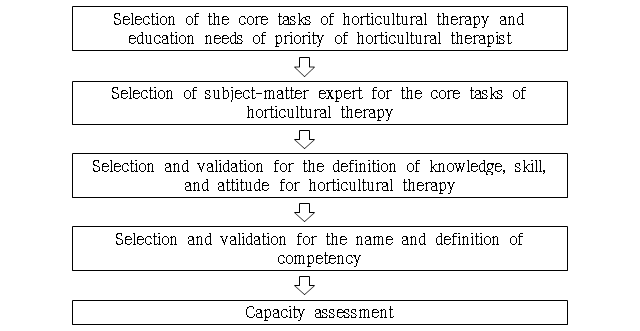Barrass R. Vocabulary for introductory courses in biology: Necessary and misleading terms. J. Biol. Educ 1979;13:79–191.

Borich CD. A needs assessment model for conducting follow-up studies. J. Teacher Educ 1980;31:39–42.

Cha MJ. Effect of horticultural therapy based on social skills training of the multimodal on the change of sociality for the physical disabled children. MS Diss 2009;Konkuk Univ; Seoul. Korea.
Cho WK, Cho MK, Im EE, Son KC. Studies of actual conditions of horticultural therapists' activities and the promotion of their status. J. Kor. Soc. People. Plants. Environ 2007;10:12–138.
Choi YA. Horticultural therapy. 2003;Hakjisa; Seoul, Korea.
DeOnna D. DACUM a versatile competency-based framework for staff development. J. Nurses Staff Dev 2002;18:5–13.


Doz Y, Thanjeiser H. Embedding transformational capability. In ICEDR(ed.), ICEDR Forum 1996;ICEDR; Boston.
Ha SY. Study on programs of forest interpreter's training courses. PhD Diss 2006;Seoul National Univ; Seoul, Korea.
Han DH. A study on the current state and the developmental direction of horticultural therapist training course. PhD Diss 2008;Cheju National Univ; Jeju, Korea.
Han KH. The configuration of group horticultural therapy model and its application. PhD Diss 2009;Dankook Univ; Chunan, Korea.
Hong MO. Effect of horticultural therapy based upon empowerment model on the improvement of self esteem and parent efficacy of disable children's mother. MS Diss 2009;Konkuk Univ; Seoul. Korea.
Jeon SJ. Effect of gestalt-theraputic horticulture program based upon the 7th educational curriculum on the improvement of self-esteem and academic achievement in vocational high school students. MS Diss 2009;Konkuk Univ; Seoul. Korea.
Kim JM. Developing a curriculum centered on competency for developing the human resources of an enterprise. J. Vocational Educ. Res 2001;20:109–128.
Kim SH. Meta-analysis for the effectiveness of researches related to horticultural therapy. MS Diss 2007;Konkuk Univ; Seoul. Korea.
Kim SS, You OS, Kwon IG, Moon SM, Sung YH. Developing of classification system for critical care and core competencies of advanced practice nurse. Clinical Nursing Res 2005;11:165–177.
Kim SY. Job analysis of horticultural therapist using DACUM and design of competency-based curriculum. PhD Diss 2010;Konkuk Univ; Seoul. Korea.
Kim SY, Park SA, Son KC, Lee C. Horticultural therapy: Job analysis, performance evaluation, and educational needs. Kor. J. Hort. Sci. Technical 2014;32(6): 887–900.

Kochanski JT, Ruse DH. Designing a competency-based human resource organization. Human Resource Mgt 1996;35:19–33.

Kwon IS. A study of teachers' conception on english teacher education program. MS Diss 2004;Inha Univ; Incheon. Korea.
Lee C, Jung CY, Kim JM, Park SY, Moon H, Kuem EJ. Education and training program design to support the worker's career development. J. Agr. Educ. Human Resource Dev 2008;40:191–223.

Lee JH, Kim HJ, Lee SM, Lee AK, Suh JK. An analysis of horticultural activities on journal of cure and rehabilitative division for horticultural therapy. J. Kor. Soc. People. Plants. Environ 2009;12:25–30.
Lee JK. Reflection on methology of developing competency based on a case of curriculum development for improving marketing competency. J. Educ. Tech 2002;18(4): 25–56.

Lee SM. An analysis of the effects of horticultural therapy to each client and the economic value by income approach. PhD Diss 2006a;Dankook Univ; Chunan. Korea.
Lee SS. Approach to rehabilitative horticultural therapy based on motion analysis of flower arrangement. PhD Diss 2006b;Konkook Univ; Seoul. Korea.
Lim WS. Study of core competency-based curriculum development: squadron officer course and command and staff course in air university. CNU J. Educ. Studies 2004;25:91–124.
Park JS, Suh CG, Han SK. Improvement of direction of job analysis for the development of vocational education and training program. Krivet. Seoul. Korea 2005;59–61.
ParParry SR. The quest for competence. Training Magazine 1996;7;48–56.
Saunders M, Machell J. Understanding emerging trends in higher education curricula and work connections. Higher Educ. Policy 2000;13:287–302.

Son KC, Cho MK, Song JE, Kim SY, Lee SS. Practice of professional horticultural therapy. 2006;Kubook; Seoul. Korea.
Song EW. A study of supervision educational contents needs, actual condition and satisfaction. MS Diss 2003;Catholic Univ. of Korea; Pucheon, Korea.
Washer P. Revisiting key skills: A practical framwork for higher education. Quality Higher Educ 2007;13:57–67.

Yager RE. The importance of terminology in teaching K-12 science. J. Res. Sci. Teaching 1983;23:577–588.

Yoon DY, Cho SH, Bae EK. A study based on the critical review of previous research on the DACUM job analysis in Korea. Educ. Culture Res 2011;17:87–115.





